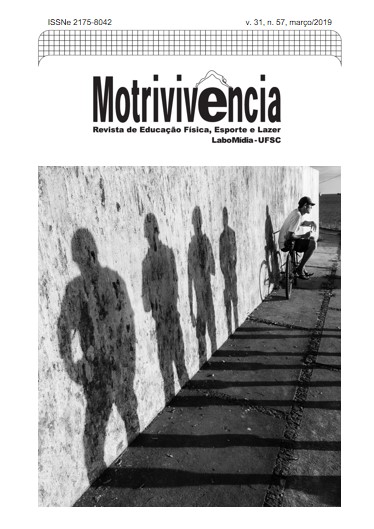The movement in the fight for life: Gladiators’ system of organization and training
DOI:
https://doi.org/10.5007/2175-8042.2019e55655Abstract
Introduction and Objective: Present the origin of gladiators, their training systems and daily life. Methodological procedures: A narrative review was carried out, based on the retrieval of historical facts contained in iconographic, electronic and bibliographical sources. Discussion: It is believed that the origin of the gladiator’s combat is Etruscan, initially realized as part of funeral rites. After entering the gladiatorial family, the gladiators followed laws from schools of formation (ludus). Gladiators who had fought for a long time, and survived all combats received a wooden sword as a symbol of their retirement, called rudis. Conclusion: For a period of almost 600 years, the arena was one of the most popular entertainments in the Roman world. Gladiator fights were an element of paganism that ruled Rome until the conversion of Emperor Constantine to Christianity in the fourth century, and occupy a central place in the modern popular perception of Roman behavior.
References
BAKER, Alan. The Gladiator: the secret history of Rome’s warrior slave. Da Capo Press, 2002.
CARTWRIGHT, Mark. Gladiator. Ancient History Encyclopedia. 6 nov. 2012.
COARELLI, Fillipo. Glianfiteatri a Roma prima Del Colosseo. Sangue e arena. Electra, Roma. 2001.
DIO, Cassius. Roman History. Loeb Classical Library edition, 1925. Livro 62, parágrafo 17, versículo 3. Disponível em: http://penelope.uchicago.edu/Thayer/E/Roman/Texts/Cassius_Dio/62*.html
DIO, Cassius. Roman History. Loeb Classical Library edition, 1925. Livro 67, parágrafo 8, versículo 4. Disponível em: http://penelope.uchicago.edu/Thayer/E/Roman/Texts/Cassius_Dio/67*.html
DUNKLE, Roger. Gladiadores: la violencia y espectáculo en la Antigua Roma. Taylor & Francis Ltd; Londres; 30 out 2008.
RACKHAM, Horace H; JONES, William Henry Samuel; EICHHOLZ, D E.Natural History. The Loeb Classical Library; 1938. By Gaius Plinius Secundus: Plinythe Elder. Disponível em: https://www.loebclassics.com/view/pliny_elder-natural_history/1938/pb_LCL419.161.xml
FUNARI, Pedro Paulo A.Resenha Thomas Wiedemann, Emperors and Gladiators. Boletim do CPA, Campinas, 1996.
GARRAFFONI, Renata Senna. Gladiadores na Roma Antiga: dos combates às paixões cotidianas. São Paulo, Annablume, Fapesp, 2005.
GREEN, Thomas A. Martial Arts of the World. Encyclopedias. Library of Congress Cataloging, 2001.
HUBBARD, Ben. Gladiators: From Spartacus to Spitfires: One-on-one combat through the ages. Canary Press: 2011.
KANZ, Fabian; GROSSSCHIMIDT, Karl. Head injuries of Roman gladiators; Forensic Science International, v.160, n.2-3, p.207-216, jul. 2006.
LAFAYE, Georges. Gladiator. Dictionnaire des Antiquités Grecques et Romains (Daremberg-Saglio), Paris, 1896.
LONGO, Umile Giuseppe; SPIEZIA, Filippo; MAFFULLI, Nicola; DENARO, Vincenzo. The best athletes in Ancient Rome were vegetarian! Journal of Sports Science & Medicine, v.7 n.4, p.565, dez. 2008.
LÖSH, Sandra; MOGHADDAM, Negahnaz; GROSSSCHMIDT, Karl; RISSER, Daniele U.; KANZ, Fabian. Stable isotope and trace element studies on gladiators and contemporary Romans from Ephesus (Turkey, 2nd and 3rd Ct. AD) implications for differences in diet. Plos One,v. 15, n. 9, e110489, out. 2014.
MANAS, Alfonso. New evidence of female gladiators: the bronze statuette at the Museum fürKunst und Gewerbe of Hamburg. Department of Ancient History, University of Granada, Granada, Spain.The International Journal of the History of Sport, v. 28, n. 18, p.2726-2752, nov. 2011.
MANAS, Alfonso. Evolution of retiarius fighting technique: abandoning the net? The International Journal of the History of Sports, v. 33, n.6-7, p.704-733,
MARKS, Paul. Gladiators fought by the book. New Scientist, v. 18, n. 2540, p. 17, fev. 2006.
MARTÍNEZ, José Maria Blázquez. Possibles Precedentes Prerromanos de los combates de gladiadores em la Península Ibérica. Alicante: Biblioteca Virtual Miguel de Cervantes, 2006. Disponível em: http://www.cervantesvirtual.com/bib/portal/antigua/
MATTESINI, Silvano. Gladiators. Associazione Culturale Archeos, 2013.
MEIJER, Fik. The Gladiators: history’s most deadly sport. Amsterdam:Atheneum-Polak& Van Gennep, 2003.
MOURATIDIS, John. On the origin of the gladiatorial games. Nikephoros, v. 1, n. 9, p. 111-134, fev. 1996.
NOORDERGRAAF, Abraham. Blood in Motion. Philadelphia: Springer, 2011.
PALLICER, Antonia Fornes; ESCALONA, Mercè Puig Rodríguez. Los gestos com el pulgar em los combates de gladiadores.Latomus, v. 65, n. 4, p. 963-971, out-dez. 2006.
PENA, Sérgio D. J.et al. The genomic ancestry of individuals from different geographical regions of Brazil is more uniform than expected. Plos One, v.6, n.2,e17063,fev. 2011.
POLIAKOFF, Michael B. Combat Sports in the Ancient World: competition, violence, and culture. London: Yale University Press, 1995.
REID, Heather L. Was the Roman Gladiator an Athlete? Journal of the Philosophy of Sport, v. 33, n. 1, p. 37-49, jan. 2006.
REDONET, Fernando Lillo. Taller de Gladiadores de Lillus Maximus, 2009. Disponível em: http://fernandolillo.blogspot.com.br/2009/12/taller-de-gladiadores-de-lillus-maximus.html
RIVER, Charles. The Roman Gladiators: the history and legacy of ancient Rome's most famous warriors. New York: Charles River Editors, 2013.
SCARBOROUGH, John. Galen and the Gladiators. ‘Episteme’ 5 (1971), 98-111; Revised with an ‘Epilogue’ 2013.
WATKINS, Richard, Gladiator. Washington: HMH Books for Young Readers, 2000.
WISDOM, Stephen. Gladiators: 100 BC-AD 200.Oxford: Osprey Publishing, 2001.
Downloads
Published
How to Cite
Issue
Section
License
Os autores dos textos enviados à Motrivivência deverão garantir, em formulário próprio no processo de submissão:
a) serem os únicos titulares dos direitos autorais dos artigos,
b) que não está sendo avaliado por outro(s) periódico(s),
c) e que, caso aprovado, transferem para a revista tais direitos, sem reservas, para publicação no formato on line.
Obs.: para os textos publicados, a revista Motrivivência adota a licença Creative Commons “Atribuição - Não Comercial - Compartilhar Igual 4.0 Internacional” (CC BY-NC-SA).



